A Detailed Report on Customer Behaviour at Ally Fashion, Australia
VerifiedAdded on 2023/06/14
|13
|3090
|436
Report
AI Summary
This report provides an in-depth analysis of customer behaviour in the context of Ally Fashion, an Australian fashion retail company. It explores the influence of cultural factors, including beliefs and values, and social class, which defines socio-economic status, on consumer purchasing decisions. The report examines how these factors impact Ally Fashion's business, considering Australia's diverse cultural landscape and social dynamics. By analyzing these influences, the report offers recommendations to Ally Fashion to enhance its strategies and effectively cater to its target market. This document is available on Desklib, a platform providing a variety of study tools and solved assignments for students.
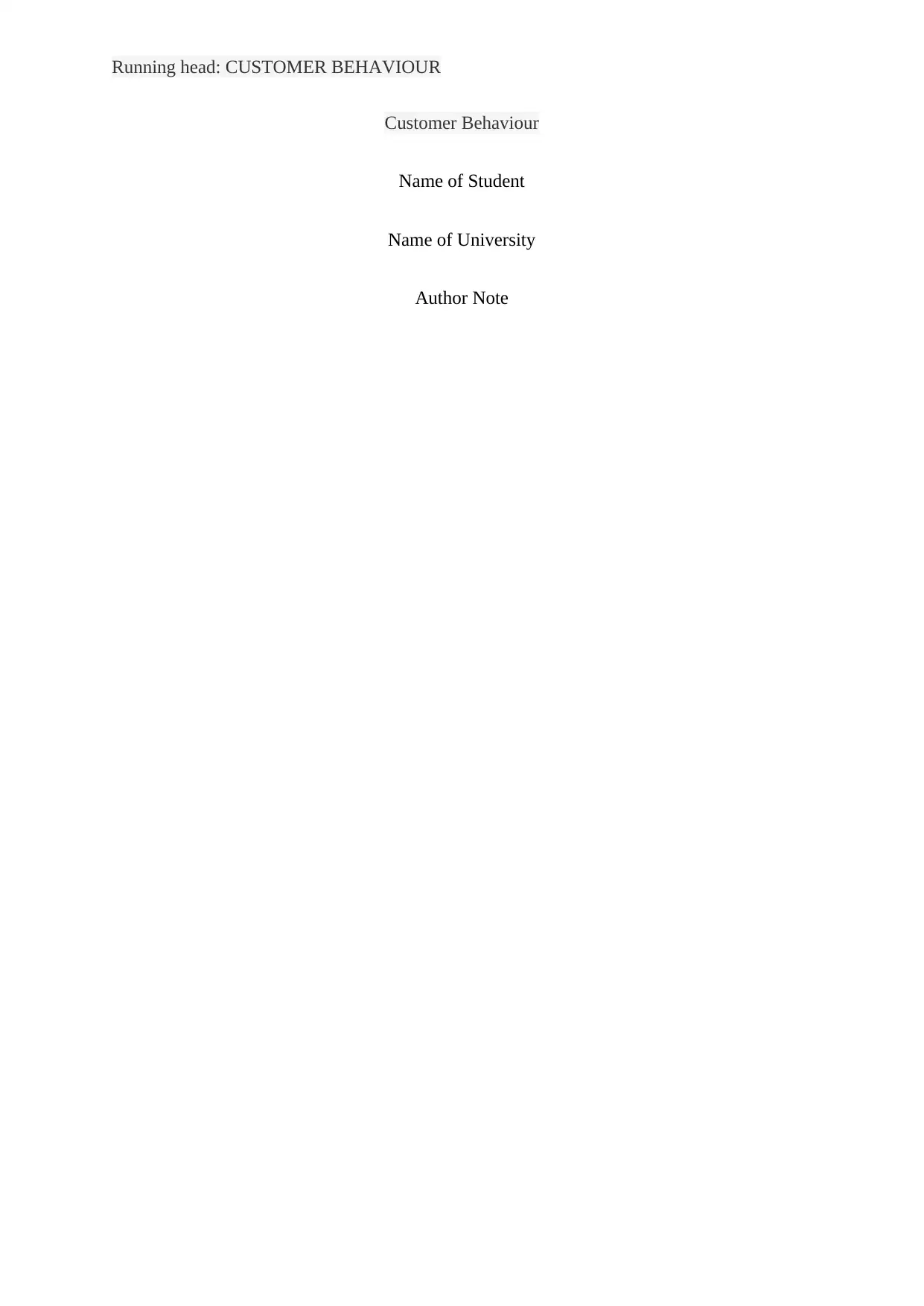
Running head: CUSTOMER BEHAVIOUR
Customer Behaviour
Name of Student
Name of University
Author Note
Customer Behaviour
Name of Student
Name of University
Author Note
Paraphrase This Document
Need a fresh take? Get an instant paraphrase of this document with our AI Paraphraser
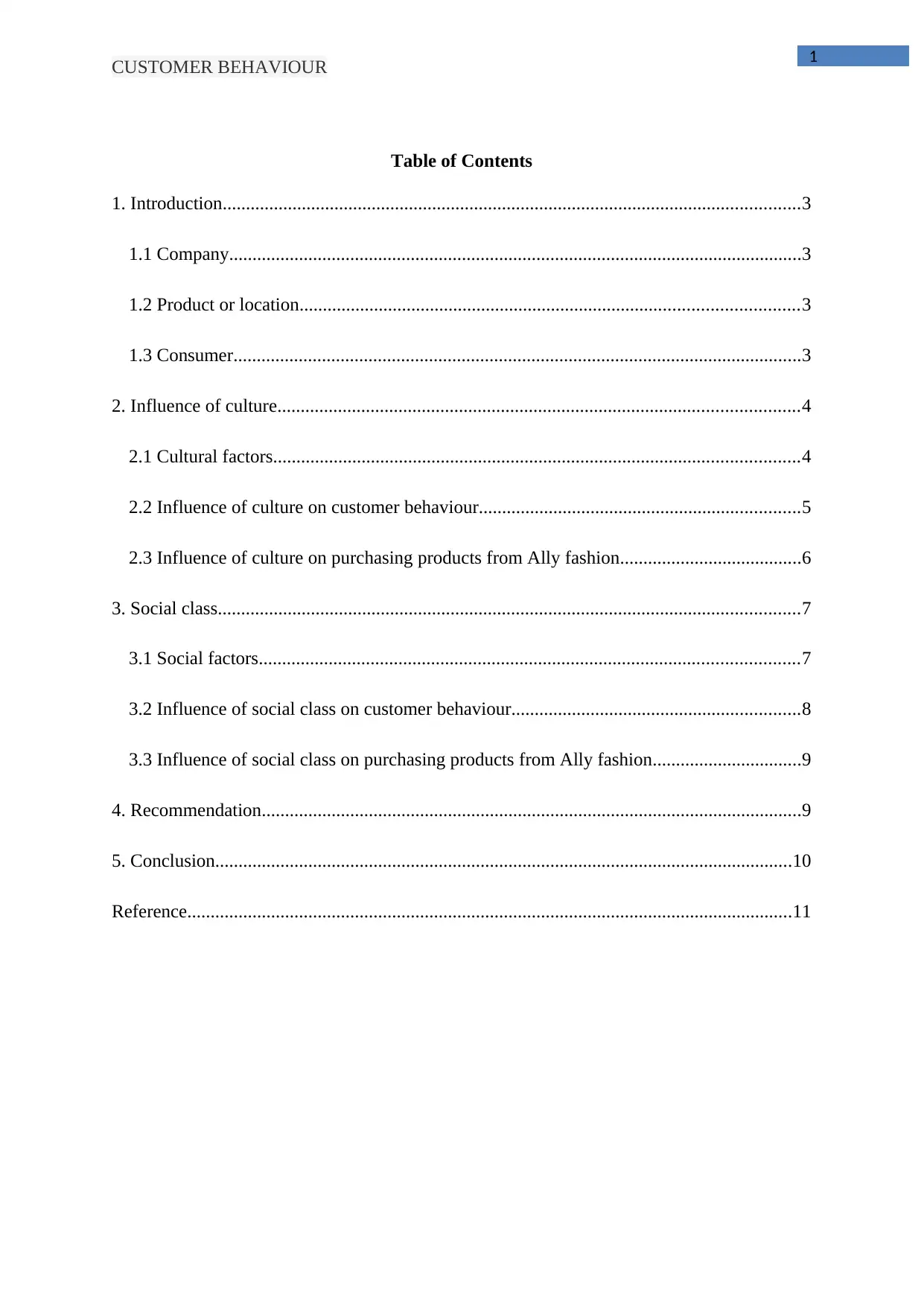
1
CUSTOMER BEHAVIOUR
Table of Contents
1. Introduction............................................................................................................................3
1.1 Company...........................................................................................................................3
1.2 Product or location...........................................................................................................3
1.3 Consumer..........................................................................................................................3
2. Influence of culture................................................................................................................4
2.1 Cultural factors.................................................................................................................4
2.2 Influence of culture on customer behaviour.....................................................................5
2.3 Influence of culture on purchasing products from Ally fashion.......................................6
3. Social class.............................................................................................................................7
3.1 Social factors....................................................................................................................7
3.2 Influence of social class on customer behaviour..............................................................8
3.3 Influence of social class on purchasing products from Ally fashion................................9
4. Recommendation....................................................................................................................9
5. Conclusion............................................................................................................................10
Reference..................................................................................................................................11
CUSTOMER BEHAVIOUR
Table of Contents
1. Introduction............................................................................................................................3
1.1 Company...........................................................................................................................3
1.2 Product or location...........................................................................................................3
1.3 Consumer..........................................................................................................................3
2. Influence of culture................................................................................................................4
2.1 Cultural factors.................................................................................................................4
2.2 Influence of culture on customer behaviour.....................................................................5
2.3 Influence of culture on purchasing products from Ally fashion.......................................6
3. Social class.............................................................................................................................7
3.1 Social factors....................................................................................................................7
3.2 Influence of social class on customer behaviour..............................................................8
3.3 Influence of social class on purchasing products from Ally fashion................................9
4. Recommendation....................................................................................................................9
5. Conclusion............................................................................................................................10
Reference..................................................................................................................................11
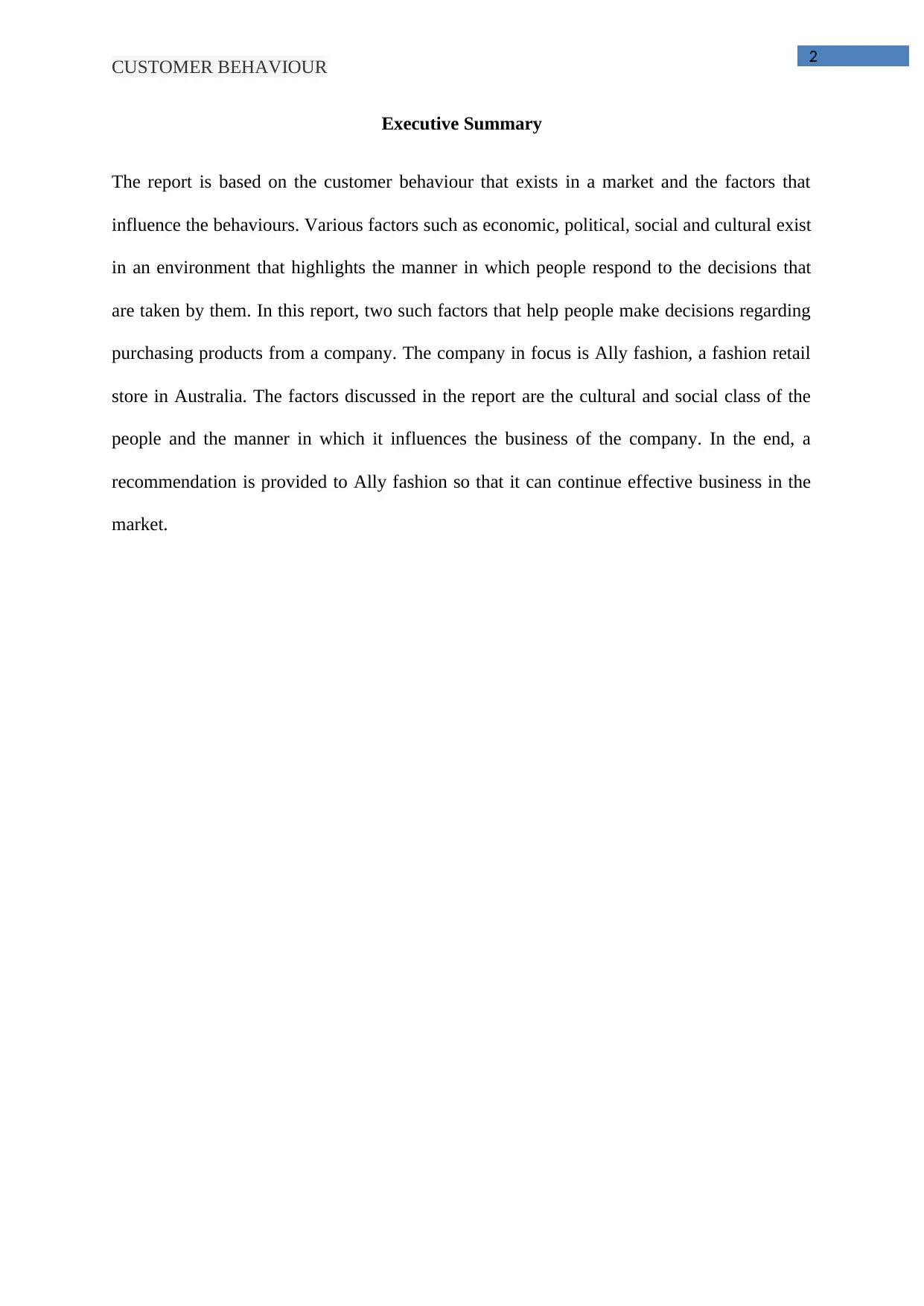
2
CUSTOMER BEHAVIOUR
Executive Summary
The report is based on the customer behaviour that exists in a market and the factors that
influence the behaviours. Various factors such as economic, political, social and cultural exist
in an environment that highlights the manner in which people respond to the decisions that
are taken by them. In this report, two such factors that help people make decisions regarding
purchasing products from a company. The company in focus is Ally fashion, a fashion retail
store in Australia. The factors discussed in the report are the cultural and social class of the
people and the manner in which it influences the business of the company. In the end, a
recommendation is provided to Ally fashion so that it can continue effective business in the
market.
CUSTOMER BEHAVIOUR
Executive Summary
The report is based on the customer behaviour that exists in a market and the factors that
influence the behaviours. Various factors such as economic, political, social and cultural exist
in an environment that highlights the manner in which people respond to the decisions that
are taken by them. In this report, two such factors that help people make decisions regarding
purchasing products from a company. The company in focus is Ally fashion, a fashion retail
store in Australia. The factors discussed in the report are the cultural and social class of the
people and the manner in which it influences the business of the company. In the end, a
recommendation is provided to Ally fashion so that it can continue effective business in the
market.
⊘ This is a preview!⊘
Do you want full access?
Subscribe today to unlock all pages.

Trusted by 1+ million students worldwide
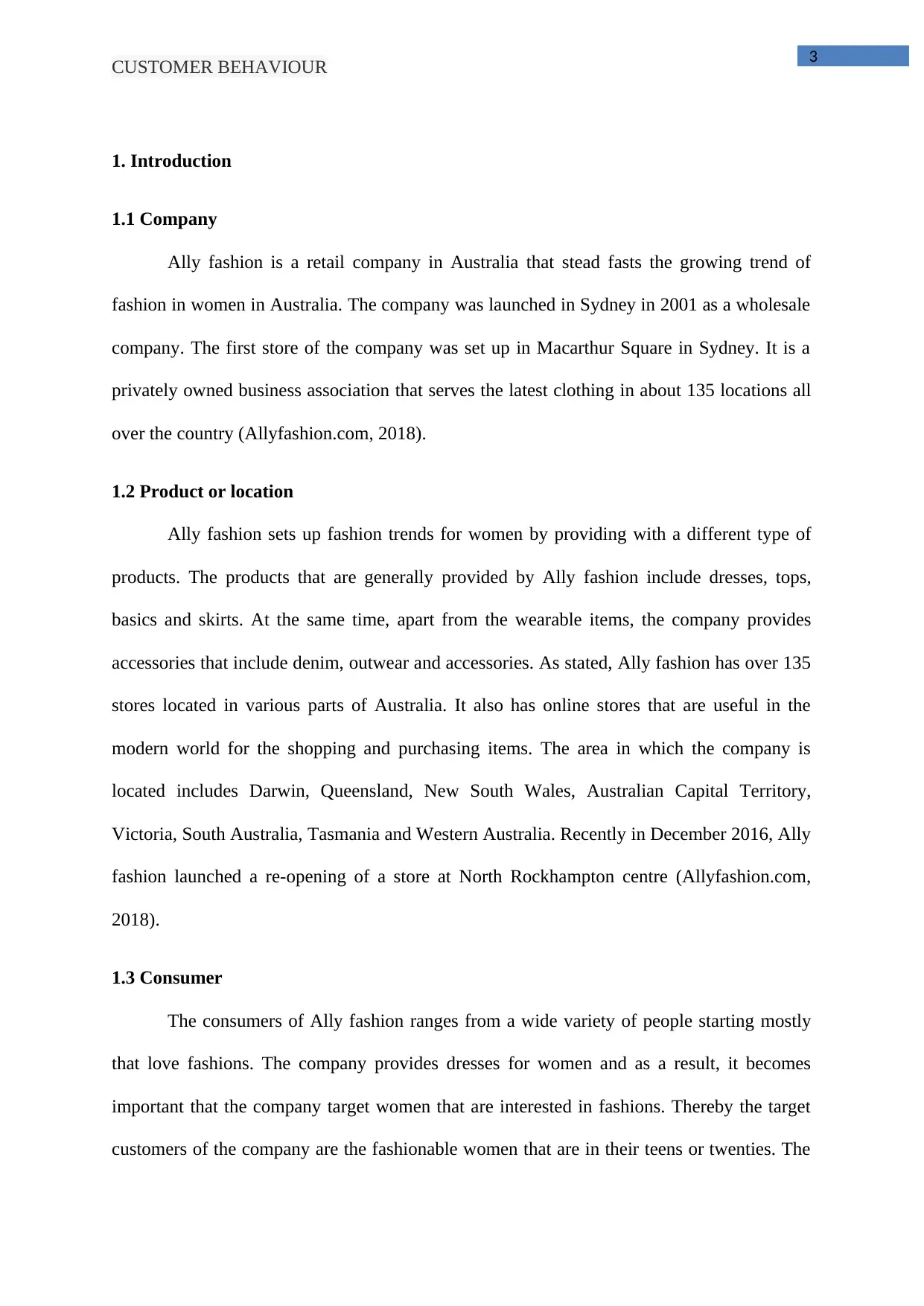
3
CUSTOMER BEHAVIOUR
1. Introduction
1.1 Company
Ally fashion is a retail company in Australia that stead fasts the growing trend of
fashion in women in Australia. The company was launched in Sydney in 2001 as a wholesale
company. The first store of the company was set up in Macarthur Square in Sydney. It is a
privately owned business association that serves the latest clothing in about 135 locations all
over the country (Allyfashion.com, 2018).
1.2 Product or location
Ally fashion sets up fashion trends for women by providing with a different type of
products. The products that are generally provided by Ally fashion include dresses, tops,
basics and skirts. At the same time, apart from the wearable items, the company provides
accessories that include denim, outwear and accessories. As stated, Ally fashion has over 135
stores located in various parts of Australia. It also has online stores that are useful in the
modern world for the shopping and purchasing items. The area in which the company is
located includes Darwin, Queensland, New South Wales, Australian Capital Territory,
Victoria, South Australia, Tasmania and Western Australia. Recently in December 2016, Ally
fashion launched a re-opening of a store at North Rockhampton centre (Allyfashion.com,
2018).
1.3 Consumer
The consumers of Ally fashion ranges from a wide variety of people starting mostly
that love fashions. The company provides dresses for women and as a result, it becomes
important that the company target women that are interested in fashions. Thereby the target
customers of the company are the fashionable women that are in their teens or twenties. The
CUSTOMER BEHAVIOUR
1. Introduction
1.1 Company
Ally fashion is a retail company in Australia that stead fasts the growing trend of
fashion in women in Australia. The company was launched in Sydney in 2001 as a wholesale
company. The first store of the company was set up in Macarthur Square in Sydney. It is a
privately owned business association that serves the latest clothing in about 135 locations all
over the country (Allyfashion.com, 2018).
1.2 Product or location
Ally fashion sets up fashion trends for women by providing with a different type of
products. The products that are generally provided by Ally fashion include dresses, tops,
basics and skirts. At the same time, apart from the wearable items, the company provides
accessories that include denim, outwear and accessories. As stated, Ally fashion has over 135
stores located in various parts of Australia. It also has online stores that are useful in the
modern world for the shopping and purchasing items. The area in which the company is
located includes Darwin, Queensland, New South Wales, Australian Capital Territory,
Victoria, South Australia, Tasmania and Western Australia. Recently in December 2016, Ally
fashion launched a re-opening of a store at North Rockhampton centre (Allyfashion.com,
2018).
1.3 Consumer
The consumers of Ally fashion ranges from a wide variety of people starting mostly
that love fashions. The company provides dresses for women and as a result, it becomes
important that the company target women that are interested in fashions. Thereby the target
customers of the company are the fashionable women that are in their teens or twenties. The
Paraphrase This Document
Need a fresh take? Get an instant paraphrase of this document with our AI Paraphraser
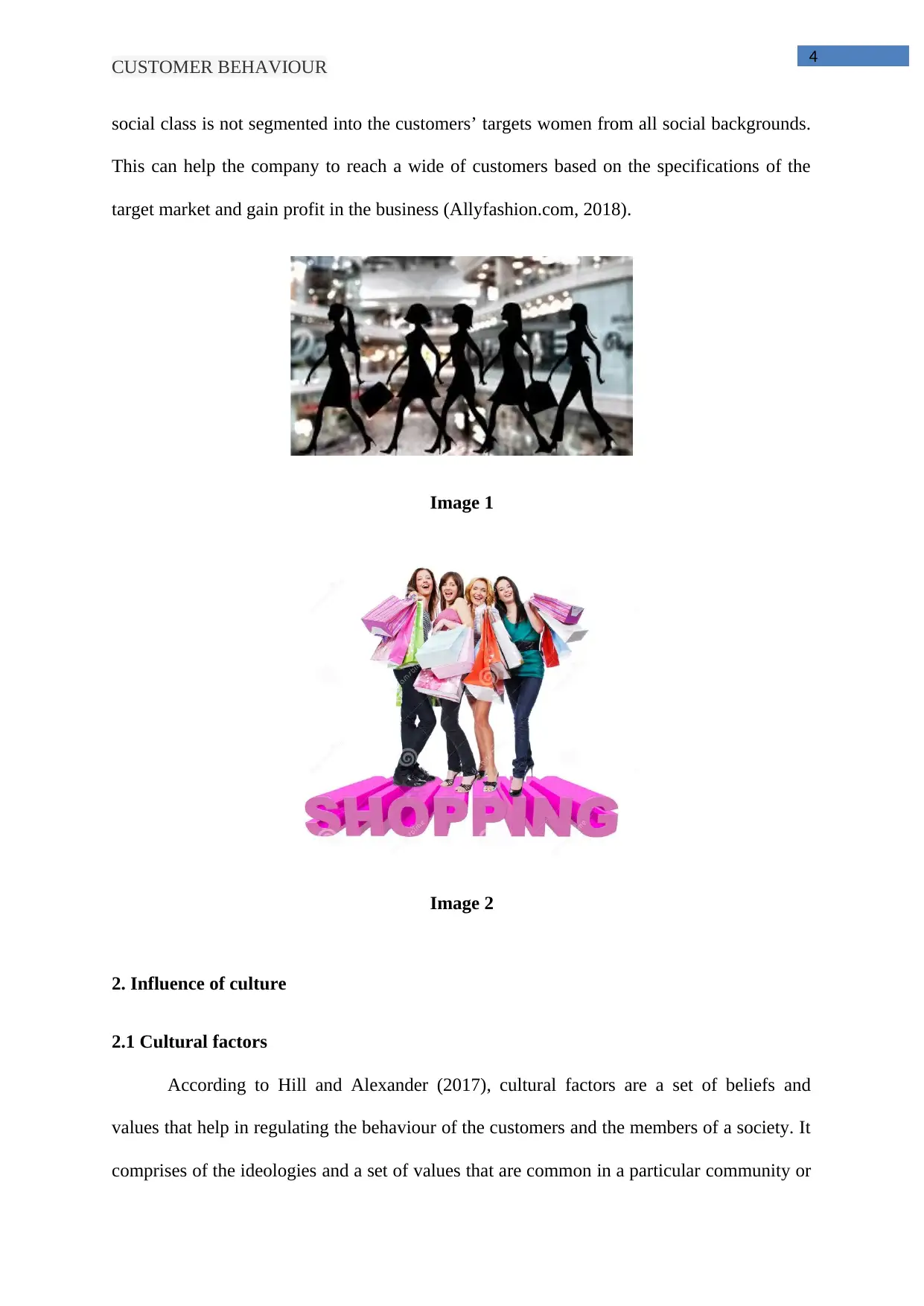
4
CUSTOMER BEHAVIOUR
social class is not segmented into the customers’ targets women from all social backgrounds.
This can help the company to reach a wide of customers based on the specifications of the
target market and gain profit in the business (Allyfashion.com, 2018).
Image 1
Image 2
2. Influence of culture
2.1 Cultural factors
According to Hill and Alexander (2017), cultural factors are a set of beliefs and
values that help in regulating the behaviour of the customers and the members of a society. It
comprises of the ideologies and a set of values that are common in a particular community or
CUSTOMER BEHAVIOUR
social class is not segmented into the customers’ targets women from all social backgrounds.
This can help the company to reach a wide of customers based on the specifications of the
target market and gain profit in the business (Allyfashion.com, 2018).
Image 1
Image 2
2. Influence of culture
2.1 Cultural factors
According to Hill and Alexander (2017), cultural factors are a set of beliefs and
values that help in regulating the behaviour of the customers and the members of a society. It
comprises of the ideologies and a set of values that are common in a particular community or
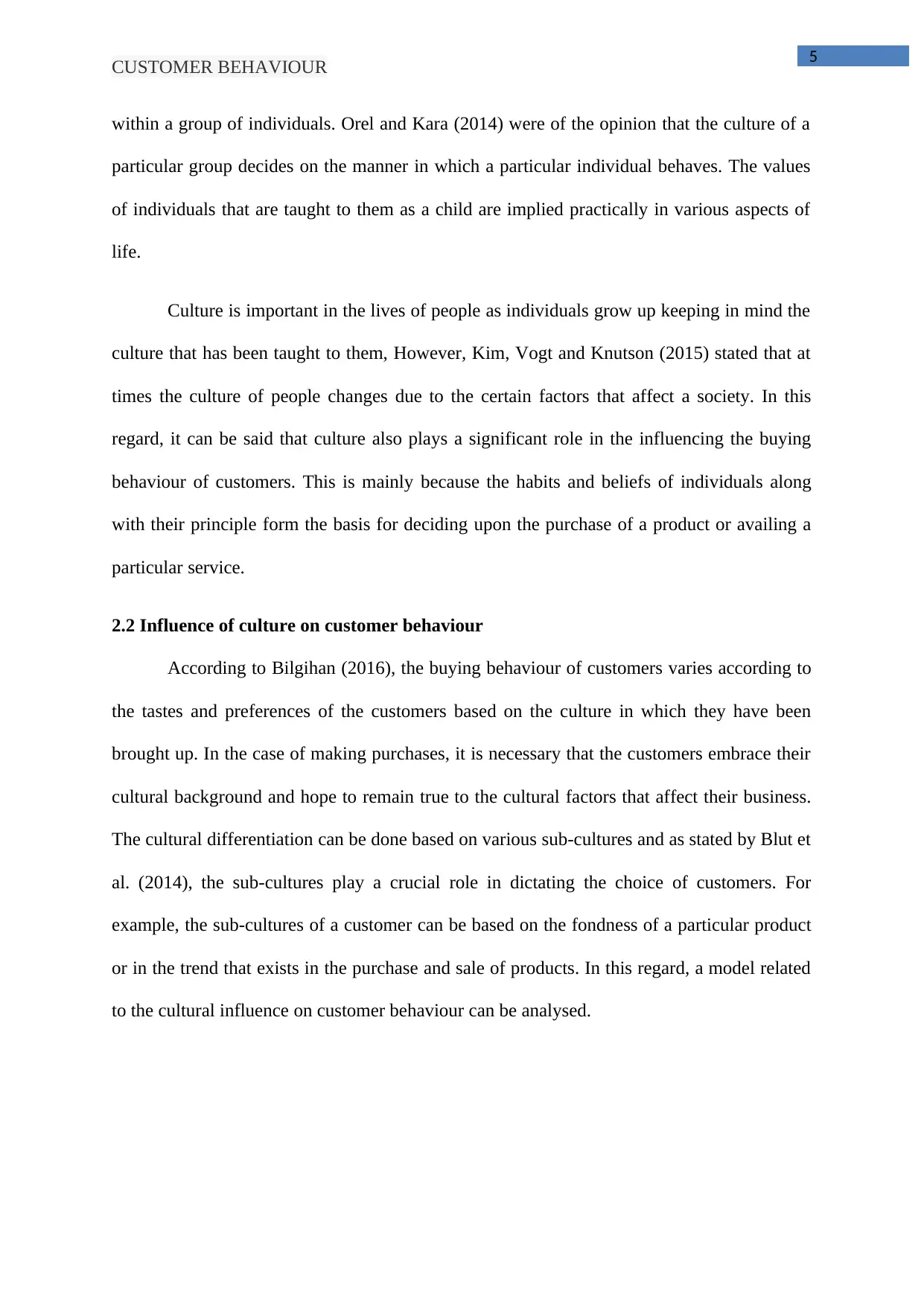
5
CUSTOMER BEHAVIOUR
within a group of individuals. Orel and Kara (2014) were of the opinion that the culture of a
particular group decides on the manner in which a particular individual behaves. The values
of individuals that are taught to them as a child are implied practically in various aspects of
life.
Culture is important in the lives of people as individuals grow up keeping in mind the
culture that has been taught to them, However, Kim, Vogt and Knutson (2015) stated that at
times the culture of people changes due to the certain factors that affect a society. In this
regard, it can be said that culture also plays a significant role in the influencing the buying
behaviour of customers. This is mainly because the habits and beliefs of individuals along
with their principle form the basis for deciding upon the purchase of a product or availing a
particular service.
2.2 Influence of culture on customer behaviour
According to Bilgihan (2016), the buying behaviour of customers varies according to
the tastes and preferences of the customers based on the culture in which they have been
brought up. In the case of making purchases, it is necessary that the customers embrace their
cultural background and hope to remain true to the cultural factors that affect their business.
The cultural differentiation can be done based on various sub-cultures and as stated by Blut et
al. (2014), the sub-cultures play a crucial role in dictating the choice of customers. For
example, the sub-cultures of a customer can be based on the fondness of a particular product
or in the trend that exists in the purchase and sale of products. In this regard, a model related
to the cultural influence on customer behaviour can be analysed.
CUSTOMER BEHAVIOUR
within a group of individuals. Orel and Kara (2014) were of the opinion that the culture of a
particular group decides on the manner in which a particular individual behaves. The values
of individuals that are taught to them as a child are implied practically in various aspects of
life.
Culture is important in the lives of people as individuals grow up keeping in mind the
culture that has been taught to them, However, Kim, Vogt and Knutson (2015) stated that at
times the culture of people changes due to the certain factors that affect a society. In this
regard, it can be said that culture also plays a significant role in the influencing the buying
behaviour of customers. This is mainly because the habits and beliefs of individuals along
with their principle form the basis for deciding upon the purchase of a product or availing a
particular service.
2.2 Influence of culture on customer behaviour
According to Bilgihan (2016), the buying behaviour of customers varies according to
the tastes and preferences of the customers based on the culture in which they have been
brought up. In the case of making purchases, it is necessary that the customers embrace their
cultural background and hope to remain true to the cultural factors that affect their business.
The cultural differentiation can be done based on various sub-cultures and as stated by Blut et
al. (2014), the sub-cultures play a crucial role in dictating the choice of customers. For
example, the sub-cultures of a customer can be based on the fondness of a particular product
or in the trend that exists in the purchase and sale of products. In this regard, a model related
to the cultural influence on customer behaviour can be analysed.
⊘ This is a preview!⊘
Do you want full access?
Subscribe today to unlock all pages.

Trusted by 1+ million students worldwide
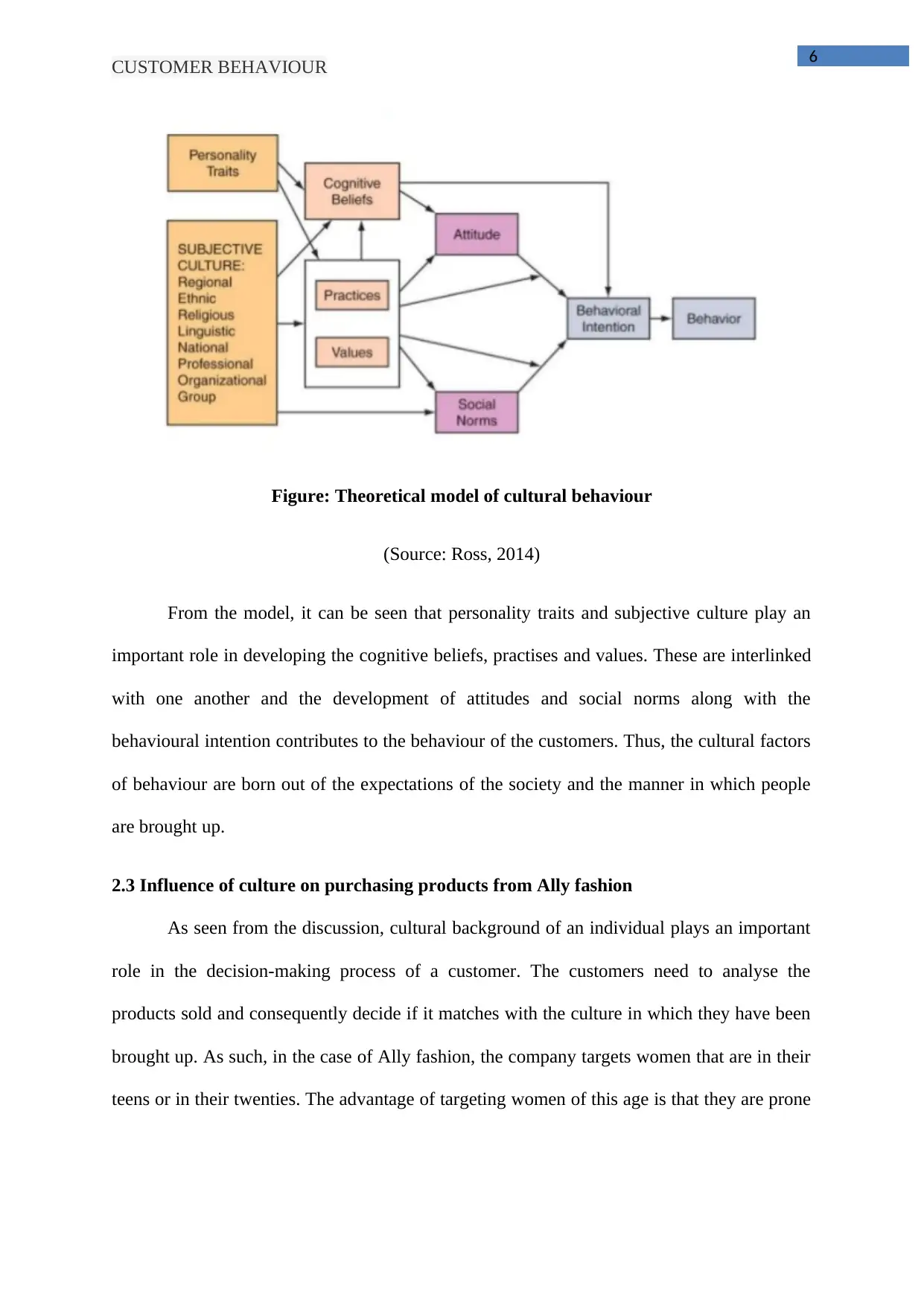
6
CUSTOMER BEHAVIOUR
Figure: Theoretical model of cultural behaviour
(Source: Ross, 2014)
From the model, it can be seen that personality traits and subjective culture play an
important role in developing the cognitive beliefs, practises and values. These are interlinked
with one another and the development of attitudes and social norms along with the
behavioural intention contributes to the behaviour of the customers. Thus, the cultural factors
of behaviour are born out of the expectations of the society and the manner in which people
are brought up.
2.3 Influence of culture on purchasing products from Ally fashion
As seen from the discussion, cultural background of an individual plays an important
role in the decision-making process of a customer. The customers need to analyse the
products sold and consequently decide if it matches with the culture in which they have been
brought up. As such, in the case of Ally fashion, the company targets women that are in their
teens or in their twenties. The advantage of targeting women of this age is that they are prone
CUSTOMER BEHAVIOUR
Figure: Theoretical model of cultural behaviour
(Source: Ross, 2014)
From the model, it can be seen that personality traits and subjective culture play an
important role in developing the cognitive beliefs, practises and values. These are interlinked
with one another and the development of attitudes and social norms along with the
behavioural intention contributes to the behaviour of the customers. Thus, the cultural factors
of behaviour are born out of the expectations of the society and the manner in which people
are brought up.
2.3 Influence of culture on purchasing products from Ally fashion
As seen from the discussion, cultural background of an individual plays an important
role in the decision-making process of a customer. The customers need to analyse the
products sold and consequently decide if it matches with the culture in which they have been
brought up. As such, in the case of Ally fashion, the company targets women that are in their
teens or in their twenties. The advantage of targeting women of this age is that they are prone
Paraphrase This Document
Need a fresh take? Get an instant paraphrase of this document with our AI Paraphraser
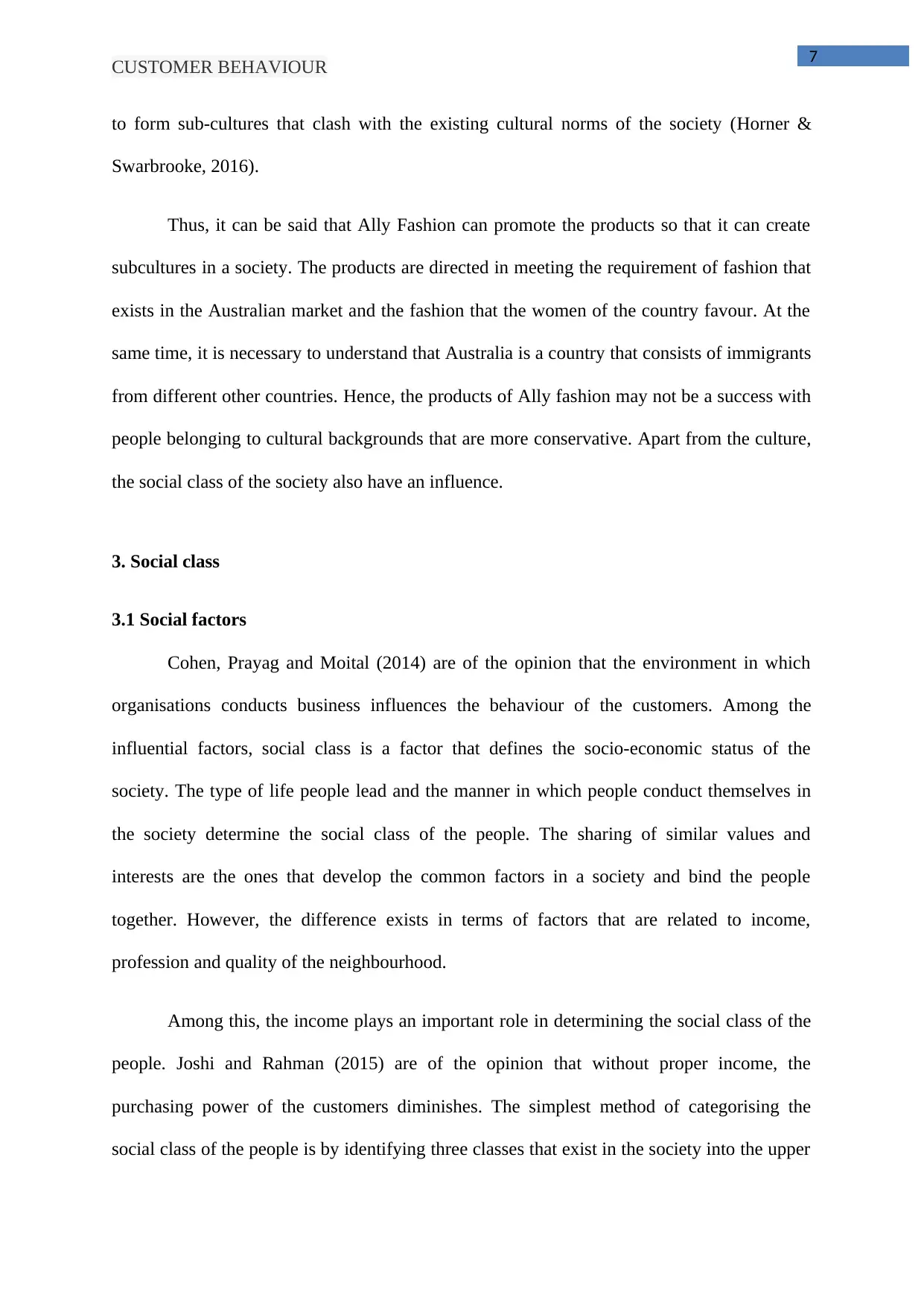
7
CUSTOMER BEHAVIOUR
to form sub-cultures that clash with the existing cultural norms of the society (Horner &
Swarbrooke, 2016).
Thus, it can be said that Ally Fashion can promote the products so that it can create
subcultures in a society. The products are directed in meeting the requirement of fashion that
exists in the Australian market and the fashion that the women of the country favour. At the
same time, it is necessary to understand that Australia is a country that consists of immigrants
from different other countries. Hence, the products of Ally fashion may not be a success with
people belonging to cultural backgrounds that are more conservative. Apart from the culture,
the social class of the society also have an influence.
3. Social class
3.1 Social factors
Cohen, Prayag and Moital (2014) are of the opinion that the environment in which
organisations conducts business influences the behaviour of the customers. Among the
influential factors, social class is a factor that defines the socio-economic status of the
society. The type of life people lead and the manner in which people conduct themselves in
the society determine the social class of the people. The sharing of similar values and
interests are the ones that develop the common factors in a society and bind the people
together. However, the difference exists in terms of factors that are related to income,
profession and quality of the neighbourhood.
Among this, the income plays an important role in determining the social class of the
people. Joshi and Rahman (2015) are of the opinion that without proper income, the
purchasing power of the customers diminishes. The simplest method of categorising the
social class of the people is by identifying three classes that exist in the society into the upper
CUSTOMER BEHAVIOUR
to form sub-cultures that clash with the existing cultural norms of the society (Horner &
Swarbrooke, 2016).
Thus, it can be said that Ally Fashion can promote the products so that it can create
subcultures in a society. The products are directed in meeting the requirement of fashion that
exists in the Australian market and the fashion that the women of the country favour. At the
same time, it is necessary to understand that Australia is a country that consists of immigrants
from different other countries. Hence, the products of Ally fashion may not be a success with
people belonging to cultural backgrounds that are more conservative. Apart from the culture,
the social class of the society also have an influence.
3. Social class
3.1 Social factors
Cohen, Prayag and Moital (2014) are of the opinion that the environment in which
organisations conducts business influences the behaviour of the customers. Among the
influential factors, social class is a factor that defines the socio-economic status of the
society. The type of life people lead and the manner in which people conduct themselves in
the society determine the social class of the people. The sharing of similar values and
interests are the ones that develop the common factors in a society and bind the people
together. However, the difference exists in terms of factors that are related to income,
profession and quality of the neighbourhood.
Among this, the income plays an important role in determining the social class of the
people. Joshi and Rahman (2015) are of the opinion that without proper income, the
purchasing power of the customers diminishes. The simplest method of categorising the
social class of the people is by identifying three classes that exist in the society into the upper
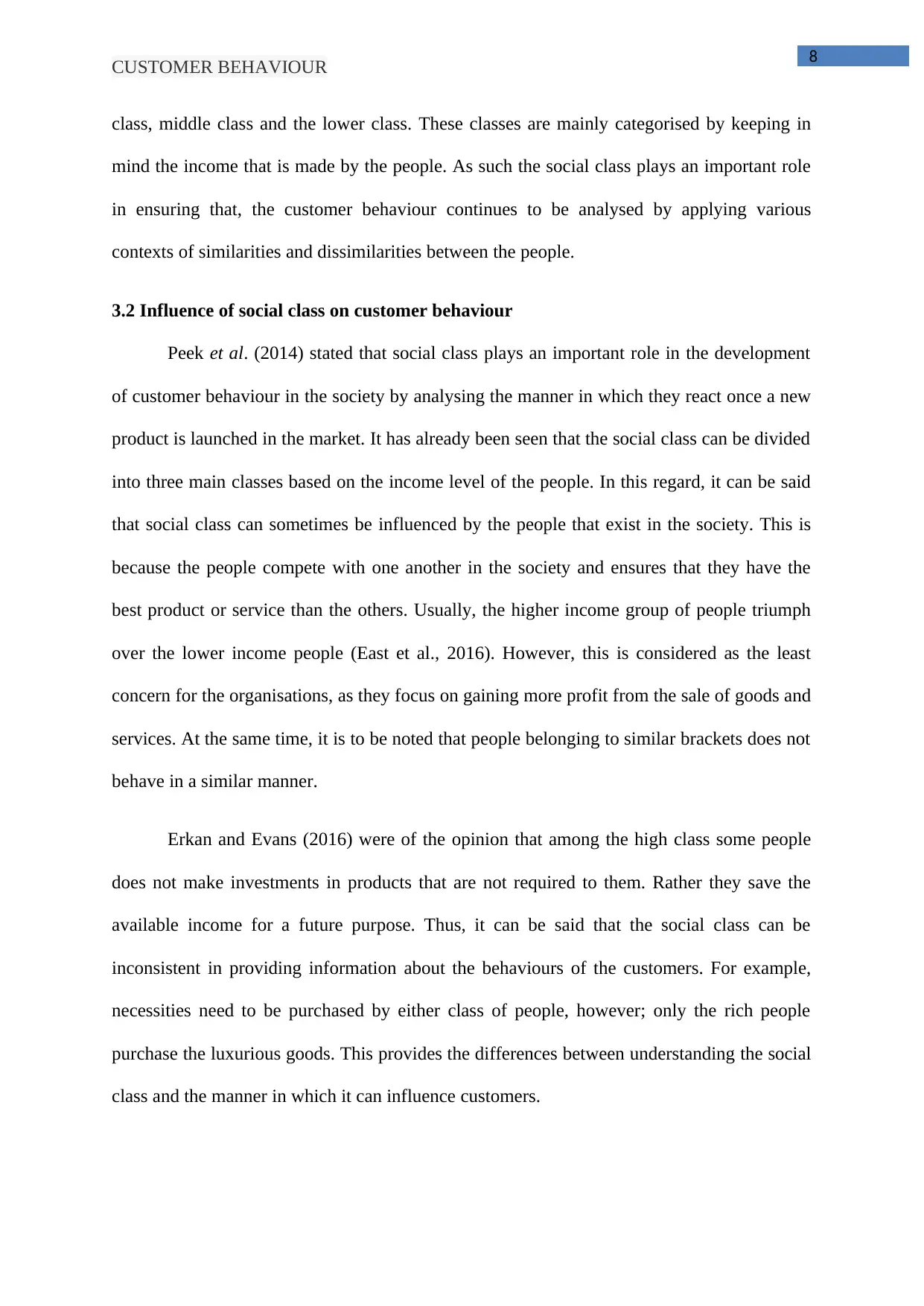
8
CUSTOMER BEHAVIOUR
class, middle class and the lower class. These classes are mainly categorised by keeping in
mind the income that is made by the people. As such the social class plays an important role
in ensuring that, the customer behaviour continues to be analysed by applying various
contexts of similarities and dissimilarities between the people.
3.2 Influence of social class on customer behaviour
Peek et al. (2014) stated that social class plays an important role in the development
of customer behaviour in the society by analysing the manner in which they react once a new
product is launched in the market. It has already been seen that the social class can be divided
into three main classes based on the income level of the people. In this regard, it can be said
that social class can sometimes be influenced by the people that exist in the society. This is
because the people compete with one another in the society and ensures that they have the
best product or service than the others. Usually, the higher income group of people triumph
over the lower income people (East et al., 2016). However, this is considered as the least
concern for the organisations, as they focus on gaining more profit from the sale of goods and
services. At the same time, it is to be noted that people belonging to similar brackets does not
behave in a similar manner.
Erkan and Evans (2016) were of the opinion that among the high class some people
does not make investments in products that are not required to them. Rather they save the
available income for a future purpose. Thus, it can be said that the social class can be
inconsistent in providing information about the behaviours of the customers. For example,
necessities need to be purchased by either class of people, however; only the rich people
purchase the luxurious goods. This provides the differences between understanding the social
class and the manner in which it can influence customers.
CUSTOMER BEHAVIOUR
class, middle class and the lower class. These classes are mainly categorised by keeping in
mind the income that is made by the people. As such the social class plays an important role
in ensuring that, the customer behaviour continues to be analysed by applying various
contexts of similarities and dissimilarities between the people.
3.2 Influence of social class on customer behaviour
Peek et al. (2014) stated that social class plays an important role in the development
of customer behaviour in the society by analysing the manner in which they react once a new
product is launched in the market. It has already been seen that the social class can be divided
into three main classes based on the income level of the people. In this regard, it can be said
that social class can sometimes be influenced by the people that exist in the society. This is
because the people compete with one another in the society and ensures that they have the
best product or service than the others. Usually, the higher income group of people triumph
over the lower income people (East et al., 2016). However, this is considered as the least
concern for the organisations, as they focus on gaining more profit from the sale of goods and
services. At the same time, it is to be noted that people belonging to similar brackets does not
behave in a similar manner.
Erkan and Evans (2016) were of the opinion that among the high class some people
does not make investments in products that are not required to them. Rather they save the
available income for a future purpose. Thus, it can be said that the social class can be
inconsistent in providing information about the behaviours of the customers. For example,
necessities need to be purchased by either class of people, however; only the rich people
purchase the luxurious goods. This provides the differences between understanding the social
class and the manner in which it can influence customers.
⊘ This is a preview!⊘
Do you want full access?
Subscribe today to unlock all pages.

Trusted by 1+ million students worldwide
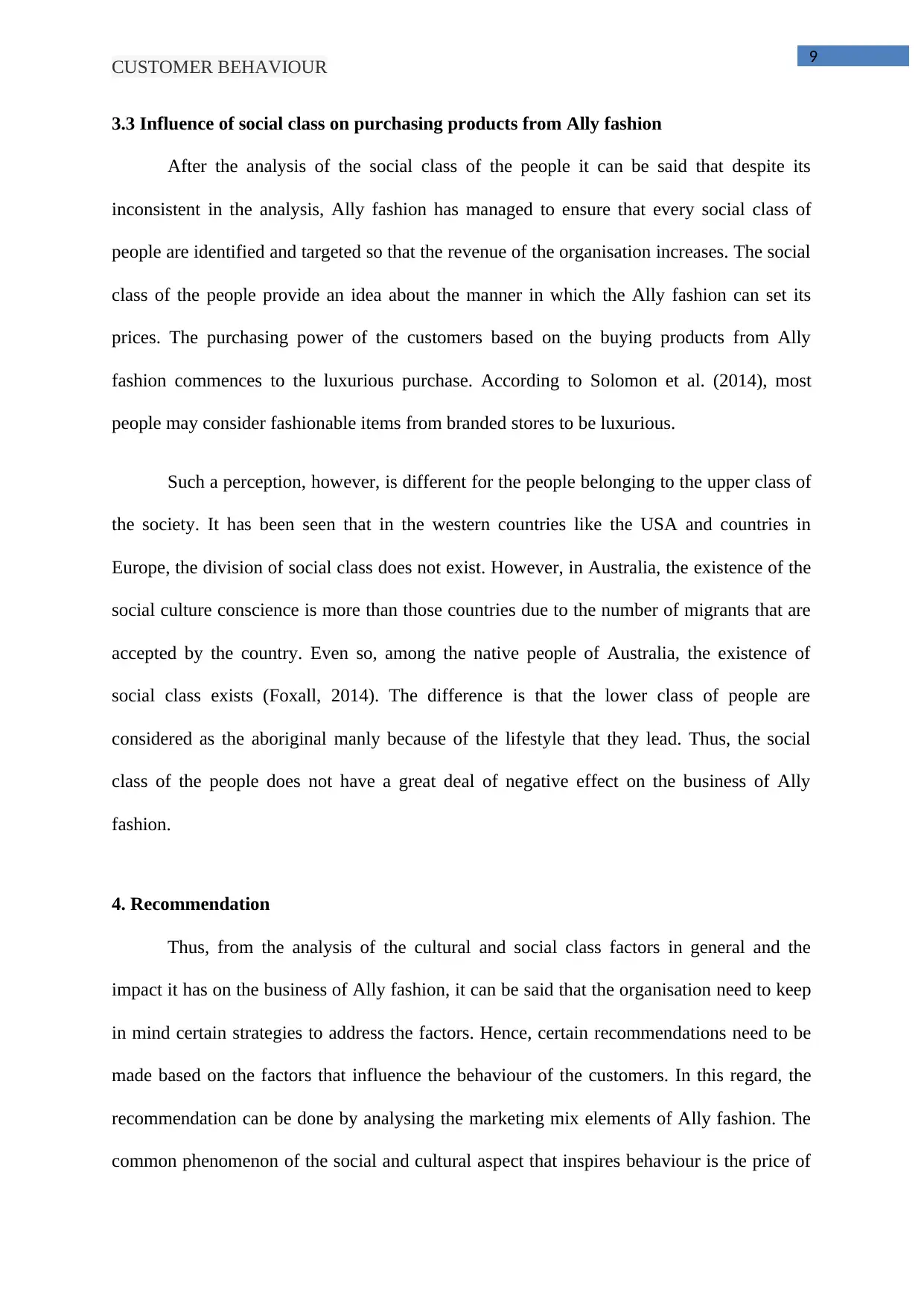
9
CUSTOMER BEHAVIOUR
3.3 Influence of social class on purchasing products from Ally fashion
After the analysis of the social class of the people it can be said that despite its
inconsistent in the analysis, Ally fashion has managed to ensure that every social class of
people are identified and targeted so that the revenue of the organisation increases. The social
class of the people provide an idea about the manner in which the Ally fashion can set its
prices. The purchasing power of the customers based on the buying products from Ally
fashion commences to the luxurious purchase. According to Solomon et al. (2014), most
people may consider fashionable items from branded stores to be luxurious.
Such a perception, however, is different for the people belonging to the upper class of
the society. It has been seen that in the western countries like the USA and countries in
Europe, the division of social class does not exist. However, in Australia, the existence of the
social culture conscience is more than those countries due to the number of migrants that are
accepted by the country. Even so, among the native people of Australia, the existence of
social class exists (Foxall, 2014). The difference is that the lower class of people are
considered as the aboriginal manly because of the lifestyle that they lead. Thus, the social
class of the people does not have a great deal of negative effect on the business of Ally
fashion.
4. Recommendation
Thus, from the analysis of the cultural and social class factors in general and the
impact it has on the business of Ally fashion, it can be said that the organisation need to keep
in mind certain strategies to address the factors. Hence, certain recommendations need to be
made based on the factors that influence the behaviour of the customers. In this regard, the
recommendation can be done by analysing the marketing mix elements of Ally fashion. The
common phenomenon of the social and cultural aspect that inspires behaviour is the price of
CUSTOMER BEHAVIOUR
3.3 Influence of social class on purchasing products from Ally fashion
After the analysis of the social class of the people it can be said that despite its
inconsistent in the analysis, Ally fashion has managed to ensure that every social class of
people are identified and targeted so that the revenue of the organisation increases. The social
class of the people provide an idea about the manner in which the Ally fashion can set its
prices. The purchasing power of the customers based on the buying products from Ally
fashion commences to the luxurious purchase. According to Solomon et al. (2014), most
people may consider fashionable items from branded stores to be luxurious.
Such a perception, however, is different for the people belonging to the upper class of
the society. It has been seen that in the western countries like the USA and countries in
Europe, the division of social class does not exist. However, in Australia, the existence of the
social culture conscience is more than those countries due to the number of migrants that are
accepted by the country. Even so, among the native people of Australia, the existence of
social class exists (Foxall, 2014). The difference is that the lower class of people are
considered as the aboriginal manly because of the lifestyle that they lead. Thus, the social
class of the people does not have a great deal of negative effect on the business of Ally
fashion.
4. Recommendation
Thus, from the analysis of the cultural and social class factors in general and the
impact it has on the business of Ally fashion, it can be said that the organisation need to keep
in mind certain strategies to address the factors. Hence, certain recommendations need to be
made based on the factors that influence the behaviour of the customers. In this regard, the
recommendation can be done by analysing the marketing mix elements of Ally fashion. The
common phenomenon of the social and cultural aspect that inspires behaviour is the price of
Paraphrase This Document
Need a fresh take? Get an instant paraphrase of this document with our AI Paraphraser
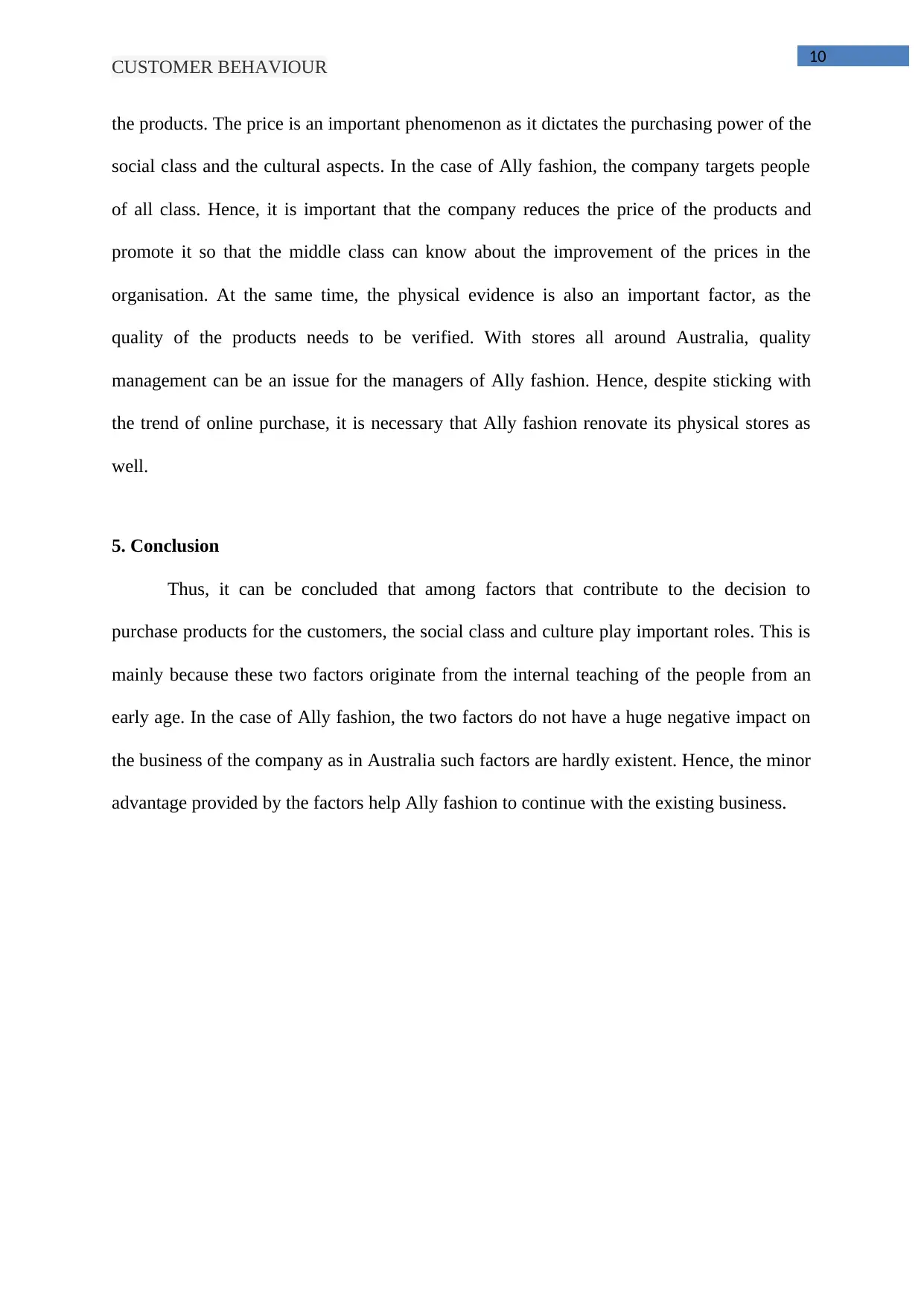
10
CUSTOMER BEHAVIOUR
the products. The price is an important phenomenon as it dictates the purchasing power of the
social class and the cultural aspects. In the case of Ally fashion, the company targets people
of all class. Hence, it is important that the company reduces the price of the products and
promote it so that the middle class can know about the improvement of the prices in the
organisation. At the same time, the physical evidence is also an important factor, as the
quality of the products needs to be verified. With stores all around Australia, quality
management can be an issue for the managers of Ally fashion. Hence, despite sticking with
the trend of online purchase, it is necessary that Ally fashion renovate its physical stores as
well.
5. Conclusion
Thus, it can be concluded that among factors that contribute to the decision to
purchase products for the customers, the social class and culture play important roles. This is
mainly because these two factors originate from the internal teaching of the people from an
early age. In the case of Ally fashion, the two factors do not have a huge negative impact on
the business of the company as in Australia such factors are hardly existent. Hence, the minor
advantage provided by the factors help Ally fashion to continue with the existing business.
CUSTOMER BEHAVIOUR
the products. The price is an important phenomenon as it dictates the purchasing power of the
social class and the cultural aspects. In the case of Ally fashion, the company targets people
of all class. Hence, it is important that the company reduces the price of the products and
promote it so that the middle class can know about the improvement of the prices in the
organisation. At the same time, the physical evidence is also an important factor, as the
quality of the products needs to be verified. With stores all around Australia, quality
management can be an issue for the managers of Ally fashion. Hence, despite sticking with
the trend of online purchase, it is necessary that Ally fashion renovate its physical stores as
well.
5. Conclusion
Thus, it can be concluded that among factors that contribute to the decision to
purchase products for the customers, the social class and culture play important roles. This is
mainly because these two factors originate from the internal teaching of the people from an
early age. In the case of Ally fashion, the two factors do not have a huge negative impact on
the business of the company as in Australia such factors are hardly existent. Hence, the minor
advantage provided by the factors help Ally fashion to continue with the existing business.
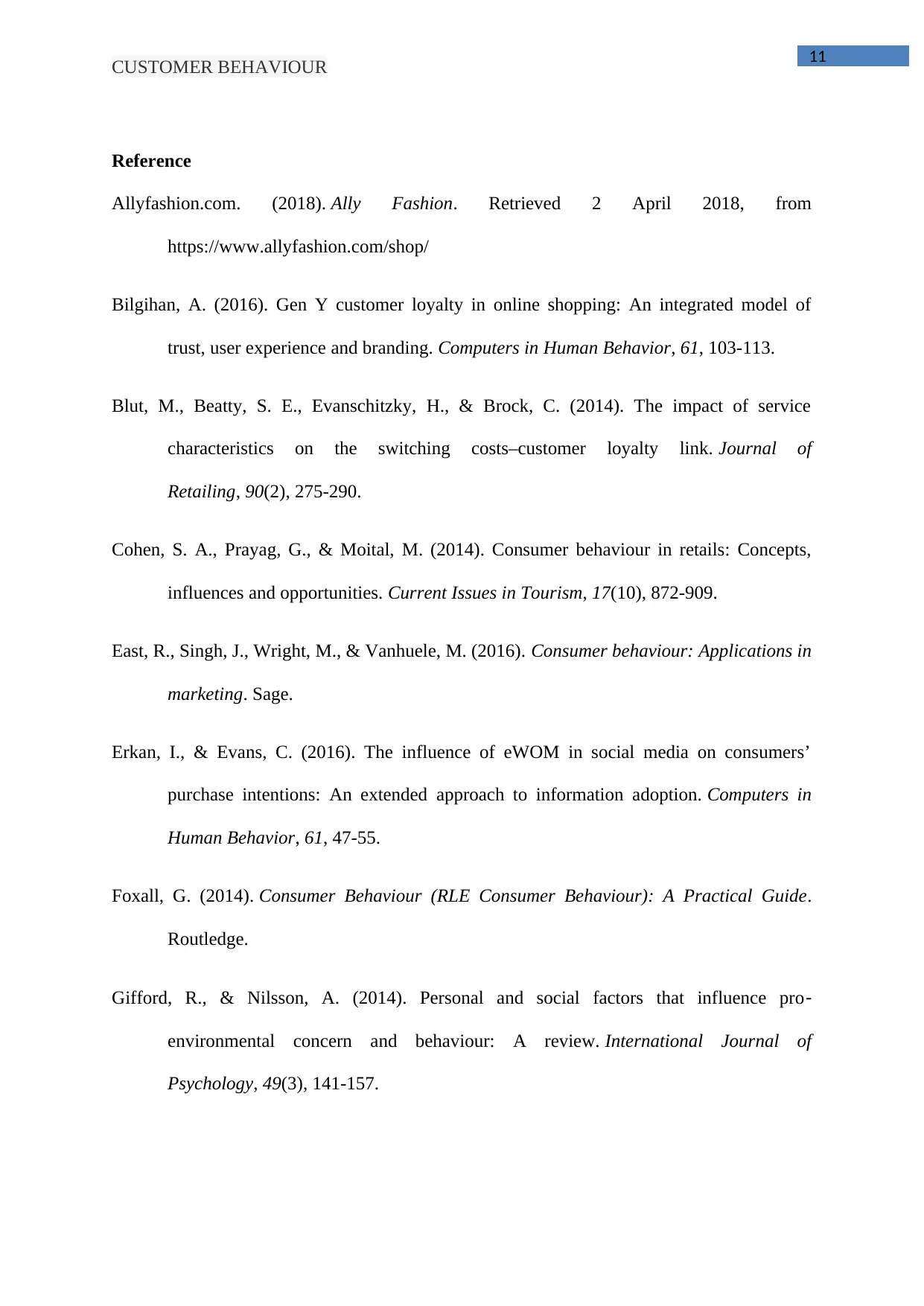
11
CUSTOMER BEHAVIOUR
Reference
Allyfashion.com. (2018). Ally Fashion. Retrieved 2 April 2018, from
https://www.allyfashion.com/shop/
Bilgihan, A. (2016). Gen Y customer loyalty in online shopping: An integrated model of
trust, user experience and branding. Computers in Human Behavior, 61, 103-113.
Blut, M., Beatty, S. E., Evanschitzky, H., & Brock, C. (2014). The impact of service
characteristics on the switching costs–customer loyalty link. Journal of
Retailing, 90(2), 275-290.
Cohen, S. A., Prayag, G., & Moital, M. (2014). Consumer behaviour in retails: Concepts,
influences and opportunities. Current Issues in Tourism, 17(10), 872-909.
East, R., Singh, J., Wright, M., & Vanhuele, M. (2016). Consumer behaviour: Applications in
marketing. Sage.
Erkan, I., & Evans, C. (2016). The influence of eWOM in social media on consumers’
purchase intentions: An extended approach to information adoption. Computers in
Human Behavior, 61, 47-55.
Foxall, G. (2014). Consumer Behaviour (RLE Consumer Behaviour): A Practical Guide.
Routledge.
Gifford, R., & Nilsson, A. (2014). Personal and social factors that influence pro‐
environmental concern and behaviour: A review. International Journal of
Psychology, 49(3), 141-157.
CUSTOMER BEHAVIOUR
Reference
Allyfashion.com. (2018). Ally Fashion. Retrieved 2 April 2018, from
https://www.allyfashion.com/shop/
Bilgihan, A. (2016). Gen Y customer loyalty in online shopping: An integrated model of
trust, user experience and branding. Computers in Human Behavior, 61, 103-113.
Blut, M., Beatty, S. E., Evanschitzky, H., & Brock, C. (2014). The impact of service
characteristics on the switching costs–customer loyalty link. Journal of
Retailing, 90(2), 275-290.
Cohen, S. A., Prayag, G., & Moital, M. (2014). Consumer behaviour in retails: Concepts,
influences and opportunities. Current Issues in Tourism, 17(10), 872-909.
East, R., Singh, J., Wright, M., & Vanhuele, M. (2016). Consumer behaviour: Applications in
marketing. Sage.
Erkan, I., & Evans, C. (2016). The influence of eWOM in social media on consumers’
purchase intentions: An extended approach to information adoption. Computers in
Human Behavior, 61, 47-55.
Foxall, G. (2014). Consumer Behaviour (RLE Consumer Behaviour): A Practical Guide.
Routledge.
Gifford, R., & Nilsson, A. (2014). Personal and social factors that influence pro‐
environmental concern and behaviour: A review. International Journal of
Psychology, 49(3), 141-157.
⊘ This is a preview!⊘
Do you want full access?
Subscribe today to unlock all pages.

Trusted by 1+ million students worldwide
1 out of 13
Related Documents
Your All-in-One AI-Powered Toolkit for Academic Success.
+13062052269
info@desklib.com
Available 24*7 on WhatsApp / Email
![[object Object]](/_next/static/media/star-bottom.7253800d.svg)
Unlock your academic potential
Copyright © 2020–2025 A2Z Services. All Rights Reserved. Developed and managed by ZUCOL.




